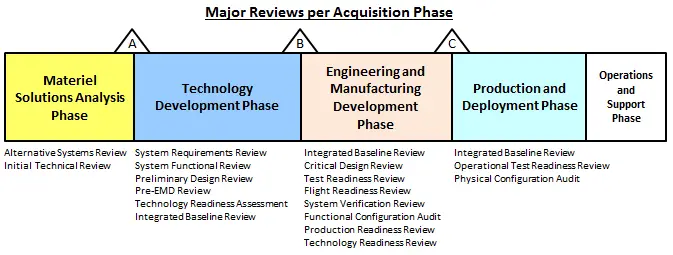The Physical Configuration Audit (PCA) examines the actual configuration of an item being produced and is conducted around the time of the Full-Rate Production Decision. It verifies that the related design documentation matches the Configuration Item (CI) as specified in the contract and confirms that the manufacturing processes, quality control system, measurement, and test equipment, and training are adequately planned, tracked, and controlled. The PCA validates many of the supporting processes used by the contractor in the production of the item and verifies other elements of the item that may have been impacted or redesigned after completion of the System Verification Review. The PCA is also used to verify that any elements of the CI that were redesigned after the completion of the Functional Configuration Audit (FCA) also meet the requirements of the CI’s performance specification. [1]
Detailed instructions and guidance for conducting PCA can be found in the:
Handbook: NAVAIR ILSM Configuration Management – Section 3
Checklist: PCA Risk Assessment
A PCA is normally conducted when the government plans to control the detailed design of the item it is acquiring via the Technical Data Package. When the government does not plan to exercise such control or purchase the item’s Technical Data Package, the contractor should conduct an internal PCA to define the starting point for controlling the detailed design of the item and establishing a product baseline. The PCA is complete when the design and manufacturing documentation match the item as specified in the contract. If the PCA was not conducted before the Full-Rate Production Decision (FRPD), it should be performed as soon as production systems are available. [1]
The PCA for a CI shall not be started unless the FCA has already been accomplished. After successful completion of the audit and the establishment of a Product Base Line (PBL), all subsequent changes are processed by formal engineering change action.
Software PCA [2]
The Software PCA is an examination of the as-coded total system software against its design or deliverable documentation. For Commercial off-the-Shelf (COTS) software this involves verification of correct documentation to support use of the software versions actually being delivered on the applicable media. Adequacy of identification and marking of all deliverable software media in accordance with contract requirements or best commercial practice is included in the PCA. The software PCA is normally conducted by government personnel at the trainer site after Government Final Inspection as soon as all final software corrective actions have been implemented.
Hardware PCA [2]
The Hardware PCA is an examination of the as-built system against its design documentation. A prerequisite for the PCA is the successful completion of an FCA. Preliminary Operation and Maintenance manuals and red-lined preliminary engineering drawings may be used when appropriate. Audits of Commercial off-the-Shelf (COTS) equipment should be limited to verification of agreement of Model/Part Numbers with system drawing parts lists and correct vendor documentation supplied. The hardware PCA is conducted jointly by the contractor and the government at the contractor’s plant prior to shipment for new trainer acquisitions.
Preliminary PCA [2]
A Preliminary PCA is normally conducted by the government during new trainer acquisitions, typically at the Critical Design Review time frame, to review reference designator number assignment plans, drawing/lists expectations, mutual understanding of contract specifications relative to the total hardware system, part identification, and markings, in-process inspections, review of contractor’s CM/QA program and evidence thereof. The hardware PCA may also be conducted incrementally when the contract involves a large system. In that case the final PCA should be conducted prior to the completion of GFI.

